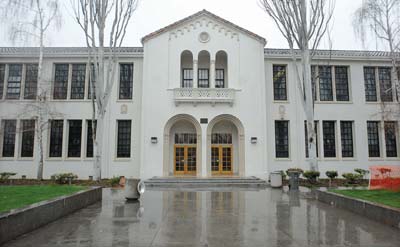The top three priorities for the proposed $42.5 million facilities bond for San Benito High School include a new vocational education complex, modernizing 64 classrooms and adding 37 new classrooms.
Other projects include improving the student parking and drop-off system, and potentially relocating the pool to make room for more classrooms at the campus core.
District trustees approved a prioritized list of five facility projects designed by a Community Facilities Committee – including staff, community members and architects – in February. Voters are set to decide on the bond June 3.
Building a new vocational center is at the top of the list. The school’s current building is at least 30 years old and would need about $2.5 million in upgrades to meet new state seismic standards, explained Trustee Ray Rodriguez. Creating a new vocational building would cost about $4 million, he said.
Modernizing about 64 existing classrooms is the next priority and could include bringing new technology to English classes and experiment stations to science labs.
“The nice thing about modernization projects is they could be matched by the state, so you could get more for your money,” said Rodriguez.
The third priority is replacing portables – many of which are more than 20 years old – with an estimated 37 new classrooms, said Rodriguez. The project comes with an estimated price tag of $15.72 million including the soft costs of designing the project and managing construction.
The fourth priority is improving the student pick-up and drop-off system and adding parking with a solar shade structure, said Rodriguez. Physical education lockers would also be added to Matson Gym so students wouldn’t have to cross Nash Road to get from the locker rooms to the sports facilities.
“We have 1,100 kids cross that Nash Road every day,” Rodriguez said.
The final item on the list is moving the pool to a different part of the campus to free up room for new classrooms in the heart of the campus.
“Everything here (on the list) is driven by our academics and this is also driven by the academics because the staff has said, ‘If we can, we would like to locate more of our academics in the core of the campus,’” Rodriguez said.
Moving the pool is also in the school’s master plan, but Trustee Bill Tiffany believes the project costs may mean the pool will be modernized but not moved.
“To implement all the parts of that master plan would cost the district considerably more than they can raise with this bond measure,” Tiffany said.
Bond opponents include Mark Hinkle, president of the Silicon Valley Taxpayers Association, who attended a presentation about the bond at the San Benito County Farm Bureau. Hinkle was disturbed to find an item on the list of possible bond projects that explained PE and athletic facilities would be improved or renovated “if needed for student welfare or to accommodate other school, classroom and lab improvements.”
“It seems very strange you should borrow money (in a bond) if you don’t know if it was needed or not,” Hinkle said in an interview.
He was also disturbed to learn some of the bond money was for technology, which will quickly become outdated while taxpayers will continue paying interest on the bond for about 25 years, he said.
“I always thought bond issues were supposed to be for capital improvements … something that was going to be around for 30 or 40 or 50 years. Technology is going to be gone in the recycle bin in three or five years,” he said.
For the full text of Measure G, a full list of facility projects that could use money from the measure and arguments for and against the bond, go to: smartvoter.org/2014/06/03/ca/sbn/meas/G.










